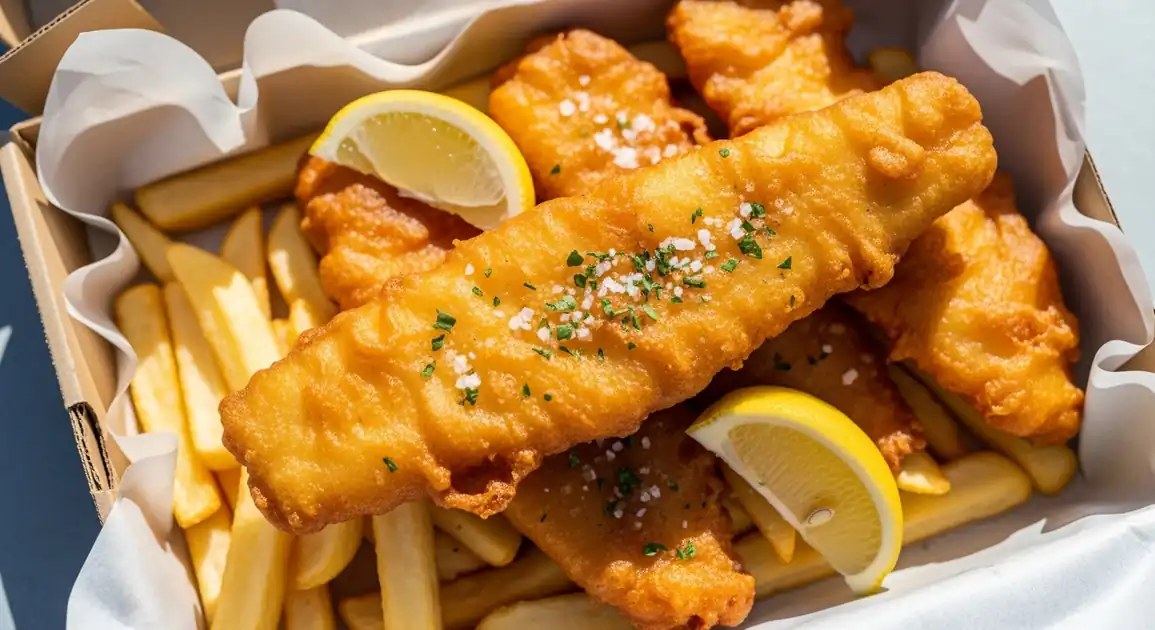Fish and Chips
Fish and Chips

Description
Fish and Chips is a national takeaway staple in Australia, found in virtually every town and suburb, especially near coastal areas. It's considered a casual, affordable meal option enjoyed by people of all ages. Quality and fish types can vary significantly by region and shop.
Dietary Information
Serving information
Serving style
Typically served wrapped in butcher's paper or in a cardboard box. Eaten casually, often takeaway, sometimes at basic tables in the shop or outdoors (picnic tables, beach). Lemon wedges and sauce sachets (tartare, tomato) are common additions.
Quick facts
Usually Lunch (approx. 11 AM/12 PM - 2 PM) and Dinner (approx. 5 PM - 8 PM/9 PM). Some open all day, especially near beaches.
Safety Tips
What to Look For
-
Fish fried fresh to order.
Ensures the fish is cooked thoroughly at a high temperature, minimizing risks and maximizing crispness.
-
Chips cooked until piping hot and golden.
Ensures chips are cooked through and served at a safe temperature.
-
Clean frying oil (light golden color, no strong 'old oil' smell).
Oil quality affects taste and potentially safety. Regularly changed oil is crucial.
-
Busy shop with high turnover.
Indicates ingredients are likely fresh due to frequent replenishment.
-
Clean premises and food handling practices.
General cleanliness reduces the risk of cross-contamination.
What to avoid
-
Pre-cooked fish or chips sitting under heat lamps for long periods.
Food held at warm temperatures can allow bacteria to grow. Best avoided unless turnover is visibly very high.
-
Very dark, sludgy, or foul-smelling cooking oil.
Indicates oil is old and breaking down, affecting taste and potentially producing harmful compounds.
-
Fish that smells overly 'fishy' or ammonia-like before cooking.
A strong indicator that the fish is not fresh.
-
Excessively greasy appearance or pooling oil.
May indicate oil temperature was too low during frying, leading to excessive oil absorption.
-
Dirty counters, equipment, or poor staff hygiene.
Increases risk of contamination.
Price information
Price range
Budget tips
- Basic fish like Hoki or Flake is usually cheaper than local premium options like Snapper or Barramundi.
- 'Minimum chips' is the standard smallest portion. Buying larger amounts is cheaper per unit.
- Lunch specials or packs (fish, chips, drink) can offer good value.
- Prices are generally higher in tourist hotspots or prime beach locations.
Value indicators
- Fresh, flaky fish with crispy (not oily) batter.
- Chips are hot, crispy outside, fluffy inside.
- Good portion size for the price.
- Cleanliness of the shop and freshness of ingredients.
Where to Find This Dish
Coastal Towns & Beach Suburbs
Highest concentration of shops catering to beachgoers and locals.
Any popular beach (Bondi, Manly, Gold Coast, Cottesloe, etc.), Seaside towns
Lunch, Dinner, Weekends
Suburban Shopping Strips
Most suburbs have at least one local fish and chip shop.
Local main streets, Small shopping centres
Dinner, Lunch
Fishing Ports/Harbours
Areas near fishing fleets often have shops selling fresh local catches.
Fremantle (WA), Sydney Fish Market (NSW), Port Lincoln (SA)
Lunch, Dinner
Vendor Tips
- Ask what fish is fresh or local today.
- Specify your salt preference (plain, chicken, light, none).
- Check cooking times if busy; popular places can have long waits on peak nights.
How to Order
Regional Variations
-
Grilled Fish
(Grilled Fish)
Fish fillet cooked on a hotplate or grill instead of battered and fried. Often seasoned with lemon pepper or herbs. A lighter option.
-
Crumbed Fish
(Crumbed Fish)
Fish fillet coated in breadcrumbs instead of batter, then deep-fried. Offers a different crispy texture.
-
Specific Fish Types (e.g., Snapper, Barramundi, Flake)
(Snapper / Barramundi / Flake)
Most shops offer choices. Flake (gummy shark) is common, Barramundi is popular, Snapper is often a premium local choice. Prices vary.
-
Chicken Salt on Chips
(Chicken Salt)
A ubiquitous savoury salt blend offered as an alternative to plain salt for seasoning chips.
-
Potato Scallop / Potato Cake
(Potato Scallop / Potato Cake)
A slice of potato battered and deep-fried. Name varies by state ('scallop' in NSW/QLD, 'cake' in VIC/SA/TAS).
-
Calamari Rings
(Calamari Rings)
Battered or crumbed squid rings, deep-fried. Common add-on.
-
Dim Sim (Australian style)
(Dim Sim)
A large, cabbage-and-meat filled dumpling, often deep-fried (or steamed). Popular fish shop extra, especially in VIC/NSW.
Cultural context
History
Originating in the United Kingdom in the mid-19th century, Fish and Chips quickly spread throughout the Commonwealth. It arrived in Australia and became firmly established as a cheap, accessible, and popular meal, particularly from the early 20th century onwards. Its popularity surged with the growth of takeaway culture and its suitability for informal eating, perfectly matching Australia's beach lifestyle. It remains an enduring culinary icon.
Local significance
An adopted national dish, symbolizing casual Australian lifestyle, beach culture, and simple pleasures. A Friday night takeaway tradition for many families.
Eating customs
- Eating directly from the paper wrapping or box.
- Using hands is common and acceptable.
- Adding vinegar (especially older generations or UK influence) or tomato sauce (ketchup).